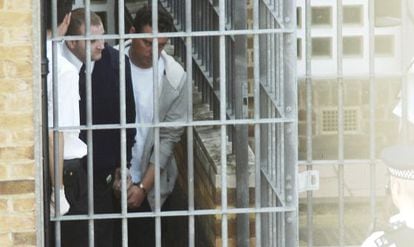“An innocent man in jail should be a priority, but nobody cares”
Despite DNA evidence, a Dutch national has been in Spanish prison since 2003 for sex attacks


Mark Dixie celebrated his 35th birthday by kidnapping, raping and then murdering a young woman named Sally Anne Bowman in London one evening in September 2005. He was later caught, and sentenced to life in prison. It has since emerged that the Australian authorities believe that he was responsible for a series of rapes and murders. Furthermore, there is DNA evidence that he committed three sexual assaults while living in the Malaga resort town of Fuengirola in 2003, for which Dutch national Romano van der Dussen was convicted and sentenced by a Spanish court that same year. Van der Dussen has been in prison ever since.
The Dutchman’s conviction was made solely on the basis of an identification parade, and despite a lack of any forensic evidence: the fingerprints found at the three crime scenes were not his, and neither was the DNA. Shortly after the sentencing, Dixie was arrested for the murder of Sally Bowman, and his DNA put on file. When the Spanish police checked the data, they found that the organic traces discovered at the scene of one of the sexual assaults in Fuengirola matched Dixie’s. The police immediately told the investigating magistrate who had overseen Van der Dussen’s case, and asked the British authorities for further information. That was seven years ago, and Van der Dussen is still in jail. A judge in Fuengirola has finally taken up the case.
The three attacks Van der Dussen was jailed for, and that the police believe Dixie committed, took place within the space of a few hours in the early hours of August 10, 2003. The first victim was attacked in the street and then raped. Less than an hour later, an attack on another woman was prevented when a car appeared, while in the third case, a resident who overheard screams shouted to the attacker that she was calling the police.
The Dutchman’s conviction was made solely on the basis of an identification parade, with no forensic evidence
The three women suffered severe injuries requiring lengthy hospital treatment. The police had Van der Dussen on their books for an incident involving a dispute with his girlfriend, but he had never been arrested.
In the identity line up, in one of which he was the only non-Spaniard, two of the victims identified him, as did the neighbor that had called the police, despite the fact the attacks took place at night in unlit locations. The third victim said that she could not identify her attacker. There were also discrepancies between the witnesses regarding whether the aggressor had long or short hair.
At his trial for attempted rape, sexual assault, and robbery, Van der Dussen said that he was in Torremolinos on the night of the attacks, but did not provide an alibi. He was sentenced to 15 years and six months in jail on May 25, 2005, and had already spent 19 months behind bars.
Two of the victims identified him in the line-up, as did a neighbor, despite the fact the attacks took place at night
Two years later, Spanish police introduced the DNA and fingerprints they had found at the crime scenes into international data checks, by which time Dixie had been arrested in the United Kingdom – they found it matched his. They then learned that Dixie had been living in Malaga from late 2002 to October 2003, precisely when the attacks took place.
In March 2007, the Spanish police presented a report on their findings to the court that had overseen the arrest and conviction of van der Dussen, recommending that a new DNA sample from Dixie be taken, “to broaden the number of genetic markers that are not included in the profile put out by Interpol” along with a sample from one of the victims. The evidence showed that it was 54 million times more likely that the genetic material in question was a mixture of the profiles of Dixie and his victim than any other two persons.
Despite the police’s best efforts, and the fact that an innocent man may have been locked up, the wheels of Spanish justice have taken a long time to begin moving. The Malaga High Court reopened the case, but both it and the original court failed to supply the documentation requested by Britain in order to apply to have a new DNA sample taken from Dixie.
Despite the police’s best efforts, the wheels of Spanish justice have taken a long time to begin moving
Van der Dussen’s lawyer has since asked for the case to be reopened by the Supreme Court, based on police reports. The Supreme Court rejected this, saying the case was closed. However, in February 2012, the Malaga High Court ordered an “urgent” review of the case and for all documentary and physical evidence to be collected. A Fuengirola court has now asked Interpol for Dixie’s fingerprints, and the UK for his DNA. He has also been targeted for investigation. “It is absolutely shameful that Romano van der Dussen is still behind bars and that no judicial proceedings have begun,” says Silverio García Sierra, van der Dussen’s lawyer, adding: “In a case like this the authorities cannot act at such a slow pace. An innocent man in jail should be a priority, but nobody cares.”










































